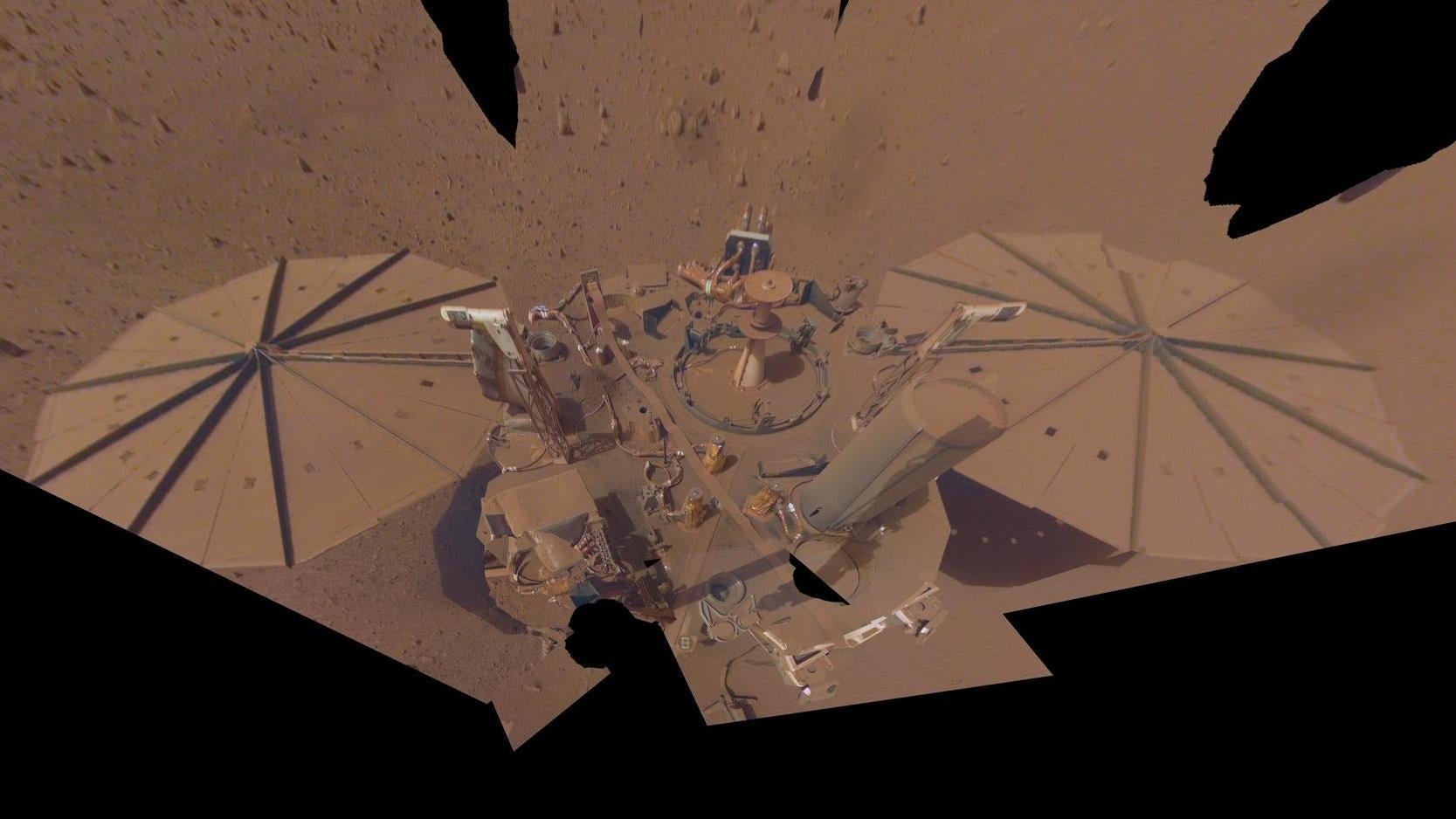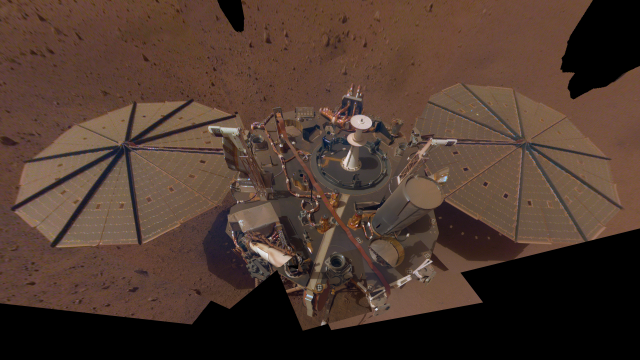NASA said today that the InSight lander mission has run out of power and is over, four years and a month after the probe landed on Mars.
The lander, designed to reveal the Martian interior, has slowly suffocated under a relentless drift of Martian dust, which covered its solar panels. The last contact occurred on December 15, and NASA announced Monday that the lander was not responding to communications.
InSight imaged the Martian surface and used its seismometer to deduce elements of Mars’ interior, such as the size of its mantle and the makeup of its core. Over four years, the lander detected meteorite impacts, seismic marsquakes, and a passing dust devil. Early on, the mission struggled with its Mole, a heat probe that was supposed to bury itself underground to take the planet’s temperature. Alas, the Martian regolith turned out to be a trickier substance than NASA anticipated.
The mission’s expected end was pushed several times, as the lander managed to persist in spite of its debilitating situation. NASA scientists performed numerous stopgap operations to prolong InSight’s life, from pouring Martian soil on its solar panels to turning off its cameras and safe modes to devote remaining battery to scientific operations.
In total, InSight detected over 1,300 marsquakes during its 1,440 sols on Mars and sent nearly 7,000 images back to Earth.
When things started looking grim for InSight, I reached out to scientists who worked on the lander as well as with the lander’s data. Here’s what they had to say about the importance of this mission.

Natalia Wojcicka, seismologist at Imperial College London:
I was lucky enough to be working on InSight during my PhD, starting just before the landing in 2018. It has been an incredible experience to be part of the mission at such an early stage of my career.
InSight achieved a great deal during its operations, giving us a never-before-seen glimpse into the properties of the Martian crust and the composition of the core and mantle. Personally, my favourite highlight is the very first seismic detection of a meteorite impact on Mars. This data has shone new light onto the properties of impact-generated seismic waves and proved that seismology is a powerful tool for studying impacts, which is of great value to the wider planetary science community.
I have no doubt that this is just the beginning for planetary seismology, and the data from InSight is going to continue being worked on for many years to come. Above all, I think InSight has shown how exciting and valuable geophysics outside of the Earth can be. I am hoping to see more seismology-based missions both to Mars and other planets in the near future.
Savas Ceylan, geophysicist at ETH Zurich:
InSight is almost a complete geophysical observatory on Mars. As the Marsquake Service, we have routinely monitored the seismic data transmitted from the InSight seismometers to identify and locate quakes. For us, there was never a dull moment when Mars did not surprise us. InSight has been on Mars for the past four years. The nominal mission duration was two Earth years. However, we are well beyond that, thanks to the spectacular work of our engineers and mission ground control units. To date, the lander and sensors have been performing exceptionally well.
The seismic data collected so far is incredibly high quality and complete. Having the seismometer package on the surface of the planet certainly helped. Using the data collected, we now have a much better understanding of the crust beneath InSight’s location, the mantle composition, and the core size. I can confidently say that we understand the Red Planet better now, from the atmosphere to the core.
This is just the beginning. Scientists will continue to analyse the data collected by InSight for decades to come. We will continue to find out about the planet. Also, there are lessons to learn for future mission designs for sure.
Brigitte Knapmeyer-Endrun, seismologist at the University of Cologne:
Mars has really kept things exciting for us — once we thought we had some basic understanding of the seismicity, the extended mission in the second Mars year came along with quite a few surprises, including the first events at more than 100 deg distance from InSight, and, quite recently, the largest marsquake ever detected with a magnitude of 5.0. Analysis of these data will surely continue for years, if not decades (like for the Apollo seismograms from the Moon) to come.
We have been able to reach all of the initial mission goals, and once we understood a bit better what the data from Mars look like, and that it might not be quite as similar to Earth or to what was modelled pre-landing as we hoped, everyone adjusted and found ways to make the most out of the data InSight provided. This included even high school students analysing seismograms from Mars, since many countries (unfortunately, not including my own) already have seismology on their curricula and could include InSight as a special case, which I think was a great idea for outreach. Right now, we as the Science Team are still in the process of analysing these distant and large events and getting more and more information on Mars, which is really intriguing and amazing.
After the extended mission brought us so much new and exciting data and discoveries, it’s sad to know that no more data will be coming in the future. But there remains much to be analysed and understood in the data we already have, and it was a really successful mission! I feel privileged for having been a part of it for more than 9 years.
As a legacy, I hope InSight has put planetary seismology back on the page. Some of the PIs have literally waited for decades to put a seismometer on Mars. After the Apollo seismometers on the Moon and the Viking experiments on Mars, all mainly in the 1970s, there hadn’t really been any focus on seismology at NASA. I believe the results from InSight show that even having a lone seismometer to cover the whole planet, and even landing where it best fits the engineering requirements and not knowing where seismic activity will be, there is a lot to learn on tectonics, interior structure, and also interaction with the atmosphere that we could never get from other experiments, and that we cannot derive from orbital measurements alone.
Though automatically deploying a super-sensitive broad-band instrument on the surface of the planet took quite some effort, it was certainly worthwhile in this case, and in other cases, there might even be simpler options. Dragonfly and the Farside Seismic Suite on Artemis might already be hinting at a revival of planetary seismology, and I’m really looking forward to what they will teach us.
Sanne Cottaar, seismologist at the University of Cambridge:
While many a rover has been moving around on the surface of Mars, InSight has been sitting there for over [four years], as quietly as possible, and its seismometer has been listening to the signals from the atmosphere and distant marsquakes. The waves that are picked up from these marsquakes reveal the seismic activity and deformation on Mars, as well as information about the deep structure they propagate through. Peeking inside another planet in this way has been both an engineering and scientific victory.
As an earthbound seismologist, I have been looking with amazement at what scientists have achieved with InSight’s data. On Earth, our techniques rely heavily on having many seismic stations, but on Mars, the scientists had to adapt to having just one seismic station. Additionally, the scientists had to understand the noise and the artefacts seen in the data to uncover the often subtle signals.
Nonetheless, they were able to detect over a thousand marsquakes, generally quite small and some quite far away. Understanding the locations, depths, and causes of this seismicity is still an ongoing venture, but it shows that while Mars does not have plate tectonics like Earth, it is still deforming in significant ways. The scientists additionally discovered waves that reflected off the core of Mars. Combining these with other waves propagating in the mantle, they were able to reveal the deep seismic structure, which gives insights to the composition and temperature of the Martian mantle. Understanding of the layers of Mars will be used in models of how Mars formed as a rocky planet, why Mars lost its magnetic field, and how Mars’ striking hemispherical topography was formed.
Recently, Mars provided InSight with a final standing ovation in the form of a magnitude 5 marsquake. This is by far the largest marsquake observed, and it certainly adjusts our thinking of how seismically active Mars is. It is exciting to see what the scientists will be able to do with the waves from this quake. The occurrence and impact of this marsquake might just pave the way to one day send multiple seismometers to Mars to continue Insight’s legacy.
